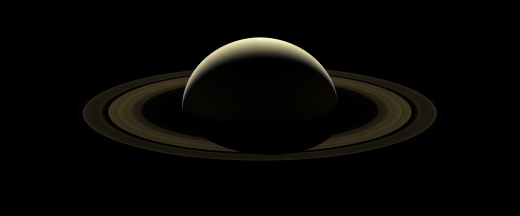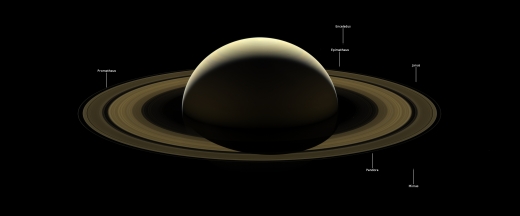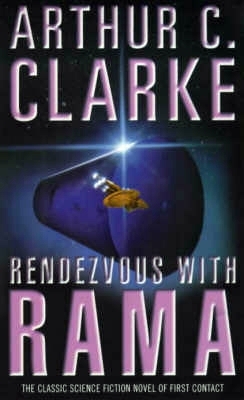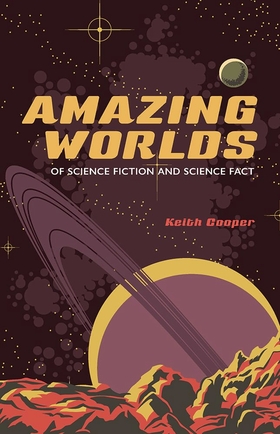Centauri Dreams
Imagining and Planning Interstellar Exploration
Cassini’s Exquisite Last View
The release of Cassini’s last images of Saturn and its rings is a welcome event, a capstone to the mission that has taught us so much. What we see below is a series of images that have been grafted together, 42 red, green and blue images that allow us to see a wide-angle mosaic of Cassini’s view. The images were taken by the spacecraft’s wide-angle camera on September 13, and include the moons Prometheus, Pandora, Janus, Epimetheus, Mimas and Enceladus.
Image: After more than 13 years at Saturn, and with its fate sealed, NASA’s Cassini spacecraft bid farewell to the Saturnian system by firing the shutters of its wide-angle camera and capturing this last, full mosaic of Saturn and its rings two days before the spacecraft’s dramatic plunge into the planet’s atmosphere. During the observation, a total of 80 wide-angle images were acquired in just over two hours. This view is constructed from 42 of those wide-angle shots, taken using the red, green and blue spectral filters, combined and mosaicked together to create a natural-color view. Credit: NASA/JPL-Caltech/SSI.
I was glad to see some Cassini team members reminiscing about Voyager, whose journeys opened up the outer Solar System to close view, and continue to inform us about the interstellar medium. Thus Carolyn Porco, former Voyager imaging team member and Cassini’s imaging team leader at the Space Science Institute in Boulder, Colorado:
“For 37 years, Voyager 1’s last view of Saturn has been, for me, one of the most evocative images ever taken in the exploration of the solar system. In a similar vein, this ‘Farewell to Saturn’ will forevermore serve as a reminder of the dramatic conclusion to that wondrous time humankind spent in intimate study of our Sun’s most iconic planetary system.”
Here is a brightened view, processed to bring out detail in the fainter areas of the image. The six moons mentioned above show up faintly, but the annotations should help.
Image: The ice-covered moon Enceladus — home to a global subsurface ocean that erupts into space — can be seen at the 1 o’clock position. Directly below Enceladus, just outside the F ring (the thin, farthest ring from the planet seen in this image) lies the small moon Epimetheus. Following the F ring clock-wise from Epimetheus, the next moon seen is Janus. At about the 4:30 position and outward from the F ring is Mimas. Inward of Mimas and still at about the 4:30 position is the F-ring-disrupting moon, Pandora. Moving around to the 10 o’clock position, just inside of the F ring, is the moon Prometheus. Credit: NASA/JPL-Caltech/SSI.
We’re looking toward the sunlit side of the rings from about 15 degrees above the ring plane, with Cassini at approximately 1.1 million kilometers from the planet and on its final approach.
Titan’s Polar Vortex
Although Cassini is gone, we have vast amounts of data that will continue to generate new discoveries for quite some time, as witness the latest, a paper out of the University Of Bristol that discusses the atmospheric chemistry on Saturn’s largest moon, Titan. Lead author Nick Teanby has been studying Titan’s upper atmosphere, where in the polar regions we are seeing unexpected cooling, a process that differs from what we see on Earth, Venus and Mars.
Indeed, Titan’s polar vortex seems to be extremely cold. What we see on the other worlds is that the high altitude polar atmosphere on a planet’s winter hemisphere is warmed as a result of sinking air heating as it is compressed. It was Cassini’s Composite Infrared Spectrometer (CIRS) instrument that produced the observations Teanby has used to study this anomaly on Titan.
CIRS data showed the expected polar hot-spot beginning to develop in 2009, but temperatures dropped significantly by 2012 and remained as low as 120 K until late 2015, after which the expected hot-spot returned. Teanby explains what’s happening this way:
“For the Earth, Venus, and Mars, the main atmospheric cooling mechanism is infrared radiation emitted by the trace gas CO2 and because CO2 has a long atmospheric lifetime it is well mixed at all atmospheric levels and is hardly affected by atmospheric circulation. However, on Titan, exotic photochemical reactions in the atmosphere produce hydrocarbons such as ethane and acetylene, and nitriles including hydrogen cyanide and cyanoacetylene, which provide the bulk of the cooling.”
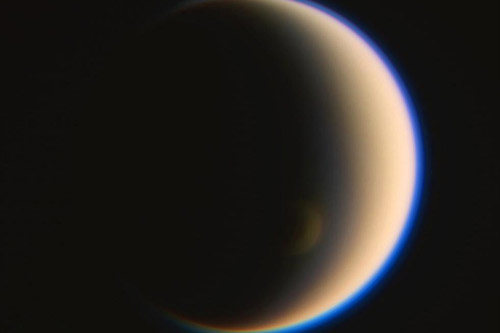
Image: Titan’s winter polar vortex imaged by the Cassini Spacecraft’s ISS camera. The vortex is now in deep winter and can only be seen because the polar clouds within the vortex extend high above Titan’s surface into the sunlight. The vortex was extremely cold from 2012-2015, giving rise to unusual nitrile ice clouds. Credit: NASA/JPL-Caltech/Space Science Institute/Jason Major.
Hydrocarbons and nitriles appear high in the atmosphere and are strongly susceptible to vertical atmospheric circulation, meaning that over the southern winter they accumulate in great amounts over the pole, creating the cooling Teanby and team are studying. The work also draws on Cassini data from 2014, when hydrogen cyanide ice clouds were observed over the pole, a reminder not only of Titan’s intriguing chemistry but the continuing vitality of Cassini data.
The paper is Teanby et al., “The formation and evolution of Titan’s winter polar vortex,” published online by Nature Communications 21 November 2017 (full text).

A Thought for the Weekend
From Arthur C. Clarke’s Interplanetary Flight: An Introduction to Astronautics (London: Temple Press Limited, 1960):
There is no way back into the past; the choice, as Wells once said, is the universe-or nothing. Though men and civilizations may yearn for rest, for the dream of the lotus-eaters, that is a desire that merges imperceptibly into death. The challenge of the great spaces between the worlds is a stupendous one; but if we fail to meet it, the story of our race will be drawing to its close.

Email Delivery Problems
Several readers have told me that their email deliveries of Centauri Dreams have not been coming through. This has been an on-again, off-again problem for some time and I’m now trying to switch providers to take care of it. Bear with me, as I hope to have the problem resolved within a few days.

Shards, Axis Ratios and Interstellar Objects

It being the day after the Thanksgiving holiday here in the States, I hadn’t planned a post, but a few more things have cropped up about ‘Oumuamua that I can quickly tuck in here. Now that I’ve learned how to pronounce it (oh MOO-uh MOO-uh), it doesn’t seem nearly as intimidating — it’s the lineup of vowels that trips up the unwary. On the other hand, Jim Benford suggested on Wednesday that we avoid the vowels altogether and call this thing ‘the Shard.’
Here’s the photo Jim sent of the Shard, a 95-story London skyscraper sometimes called The Shard of Glass. It’s 309.7 metres high, the tallest building in the United Kingdom, featuring 11,000 panes of glass with a total surface area of 56,000 square metres. What draws Jim’s attention is the 6 to 1 aspect ratio, with ‘Oumuamua’s thought to be 10 to 1. Jim might also have referenced London’s BT Tower (8 to 1), but what the Guinness Book of World Records calls the “most slender tower” turns out to be the i360 observation tower in Brighton, at a whopping 41 to 1.

With ‘Oumuamua, though, we now have to ask whether the 10 to 1 ratio is actually correct, as Jason Wright noted in a recent post. The problem here is that, unlike the situation with Boyajian’s Star, we have a small dataset to work with, and according to Wright (Penn State), researchers are getting different aspect ratios, ranging all the way from the aforementioned 10 to 1 down to a relatively ordinary 3 to 1.
If the latter is the case, the interstellar object may look something more like Haumea than the Shard. “I’ll need to see a lot more data and hard, critical analysis of the anomalies in ‘Oumuamua before I get interested in the SETI angle at the level I am for Tabby’s Star,” adds Wright.
Greg Laughlin (UC-Santa Cruz) also weighed in on ‘Oumuamua with a new paper (citation below) and accompanying article in Scientific American. Laughlin dubs our visitor “exhilaratingly bizarre” and goes on to describe its unusual arrival, in which, despite accruing 20 kilowatts of energy per square meter at perihelion, it showed no evidence of cometary activity. It was fun to see that Greg also refers to ‘Oumuamua at one point as “a crazily elongated shard.”
But what drew my attention in Greg’s post was how difficult the ejection of debris from a newly forming planetary system seems to be. Getting such a shard free from the host star demands a gravitational assist from a massive planet located at a large distance from the star — terrestrial worlds in our Solar System would fall far short, though the gas giants could manage the feat.
If objects like ‘Oumuamua are common and if they are made predominantly of ice, as we would expect in an outer stellar system, then it implies, says Laughlin, that almost every star in the Milky Way hosts a Neptune-class planet at roughly the distance of our own Neptune from the Sun.
And if it really is rock or metal? Then we deal with another scenario entirely:
…in the highly unlikely event ‘Oumuamua is indeed a refractory slab of rock or metal, as suggested by its complete lack of coma, then its appearance is extremely hard to understand. Only a few percent of stars host planets that are capable of ejecting volatile-free debris from warm regions deep within a gravitational well. They flat-out can’t generate the vast overall swarm implied by ‘Oumuamua’s recent passage, suggesting that another visit by a similar object won’t happen for a very long time.
A long time indeed. According to Laughlin’s calculations of that scenario, ‘Oumuamua could travel for 10 quadrillion years before coming into similar proximity to another star.
At that far distant time, the galaxy will be a very different place, in which all the stars that now shine warmly down on planets will be expired white dwarfs, warmed a few degrees above absolute zero by the flicker of proton decay.
The paper is Laughlin, G. & Batygin, K. (2017) “On the Consequences of the Detection of an Interstellar Asteroid,” submitted to Research Notes of the AAS (abstract).

`Oumuamua: Listening To An Interstellar Interloper
The buzz about `Oumuamua, our first known visitor from another stellar system, seems likely to continue given yesterday’s news that the object’s axis ratio is a startling 10 to 1. Given all that, Jim Benford wondered whether there were SETI implications here. Was anyone on the case from our major SETI organizations? The answer is below, as we learn that the effort is ongoing. A frequent contributor to these pages, Jim is President of Microwave Sciences in Lafayette, California, which deals with high power microwave systems from conceptual designs to hardware. He also heads up the critical sail subcommittee for Breakthrough Starshot, the effort to send small beamed sails with miniaturized payloads to a nearby star.
By James Benford

I contacted Jill Tarter and Andrew Siemion about whether SETI researchers are conducting observations of the interstellar interloper, Oumuamua. Both say yes.
Jill said that the Allen Telescope Array has been looking at it for a while. Andrew said that Breakthrough Listen was using the Green Bank Telescope for a few hours last weekend. This was actually looking for water via hydroxyl lines using broadband 1.1-1.9 GHz data. No water was immediately evident in the coarse spectra from the standard data reduction. Breakthrough Listen is working on incorporating the appropriate windowing capabilities necessary to analyze this data, so as to use their data analysis pipeline.
Therefore there are some observations in parts of the microwave spectrum.
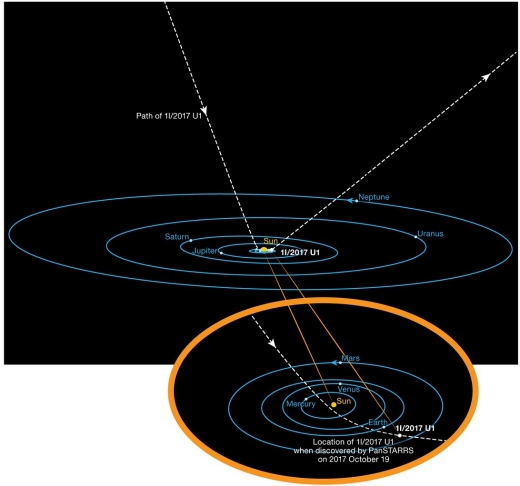
Image: This diagram shows the orbit of the interstellar asteroid ‘Oumuamua as it passes through the Solar System. Unlike all other asteroids and comets observed before, this body is not bound by gravity to the Sun. It has come from interstellar space and will return there after its brief encounter with our star system. Its hyperbolic orbit is highly inclined and it does not appear to have come close to any other Solar System body on its way in. Credit: ESO/K. Meech et al.
Besides astronomical observations of this unique object, there is also this remote possibility: That this interloper is an interstellar survey probe, having perhaps dropped down to interplanetary-scale velocities in order to take data during its transit of our solar system, before going on to another star.
If this is the case, then perhaps we ought to be looking rather broadly in the electromagnetic spectrum for any signal it might send to us, having easily detected leakage from Earth. That assumes it would try to respond to us using frequencies it knows we use. That would certainly include the microwave bands 1-10 GHz, where most of our radiation leakage radiation is.
I think at present the frequencies most observable coming from Earth are leakage of uplink transmissions to our satellites, of which there are now about 1200 active in orbit. Those frequencies tend to be in the upper end of the microwave where the wavelength is smaller, so we can use smaller apertures on both Earth and satellite. Downlinks, of course, would be absorbed in the Earth and not observable from afar.
Or, because they know enough about our atmosphere’s transmission windows and the Sun’s radiation spectrum, they might be signaling in the visible. Therefore our SETI optical observatories ought to be watching as well.
I would look for a pulsed beacon signal, which is more noticeable. That would be like a pulsar, but of course with no interstellar dispersion.
This matter has a very low probability of success, of course. However, it’s our first opportunity to observe at close range a truly interstellar object.

Image: This plot shows how the interstellar asteroid `Oumuamua varied in brightness during three days in October 2017. The large range of brightness — about a factor of ten (2.5 magnitudes) — is due to the very elongated shape of this unique object, which rotates every 7.3 hours. The different coloured dots represent measurements through different filters, covering the visible and near-infrared part of the spectrum. The dotted line shows the light curve expected if `Oumuamua were an ellipsoid with a 1:10 aspect ratio, the deviations from this line are probably due to irregularities in the object’s shape or surface albedo. Credit: ESO/K. Meech et al.

Unusual Visitor: A Deeper Look at ‘Oumuamua
When I first wrote about the interstellar interloper now called ‘Oumuamua, I made reference to Arthur C. Clarke’s Rendezvous with Rama because of the delightful symmetry between the novel and the object, though noting that ‘we’re unlikely to find that A/2017 U1 is as intriguing as Clarke’s mysterious starship bound for the Magellanics’ (see An Interstellar Visitor?). Still, an interstellar object entering the Solar System only to go careening back out of it could not help but recall Clarke, whose ‘asteroid’ 31/439 wound up being artificial.
Then came the paper from Karen Meech (University of Hawaii Institute for Astronomy, where the object was first detected with the Pan-STARRS1 telescope). Drawing on data from telescopes around the world, Meech’s team has been able to characterize our first nearby object from another stellar system, with equally delightful results. For it turns out that ‘Oumuamua (pronounced oh MOO-uh MOO-uh) has an unusual axis ratio, being about ten times longer than it is wide. Jim Benford couldn’t resist suggesting I show a cover from Rendezvous with Rama depicting just such an axis ratio, and I agreed wholeheartedly.
Any science fiction fan familiar with Clarke (and are there any who aren’t?) will have fun with the similarities, but how much do we actually know about ‘Oumuamua? Meech’s team based its conclusions on the object’s shape on the fact that its brightness changed so dramatically as it rotated (spinning on its axis every 7.3 hours). Lance Benner, who specializes in radar imaging of near-Earth and main-belt asteroids at JPL, calls the axis ratio here ‘truly extraordinary.’ We know of no Solar System objects elongated more than 3 times longer than they are wide.
Nothing in our Solar System, in other words, quite matches an object shaped like this. Of course, it might also look like the image below, courtesy of the European Southern Observatory.
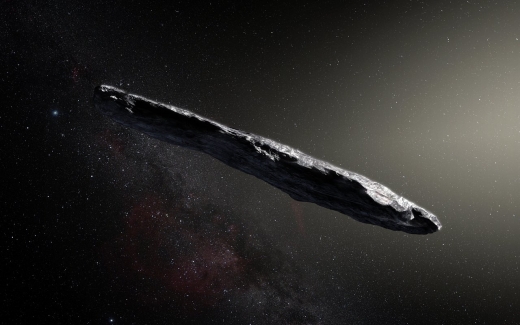
Image: This artist’s impression shows the first detected interstellar asteroid: `Oumuamua. This unique object was discovered on October 19, 2017 by the Pan-STARRS 1 telescope in Hawai`i. Subsequent observations from Gemini, ESO’s Very Large Telescope in Chile, CFHT, UKIRT, and other observatories around the world show that it was on a path which must have been travelling through interstellar space for millions of years before its chance encounter with our star system. `Oumuamua seems to be a dark red highly-elongated metallic or rocky object, about 400 meters long, and is unlike anything normally found in the Solar System. Credit: ESO/M. Kornmesser.
On the other hand, the object’s light curve, as examined through data from the Canada-France-Hawaii Telescope (CFHT), can show us rotation and likely axis ratio, but the overall observations — from the United Kingdom Infrared Telescope (UKIRT), the Keck Telescope on Mauna Kea, the Gemini South telescope, and the European Southern Observatory (ESO) Very Large Telescope (VLT) in Chile as well as CHFT — show similarities with local objects as well as differences. Here’s Karen Meech on those findings:
“While study of `Oumuamua’s colors shows that this body shares characteristics with both Kuiper Belt objects and organic-rich comets and trojan asteroids, its hyperbolic orbit says it comes from far beyond.”
The object’s dark red color is similar to Kuiper Belt objects, and the researchers believe it is dense and rocky or with high metal content, an asteroid that, according to this ESO news release, lacks significant amounts of water or ice, and one whose surface darkening and reddening is the result of millions of years of irradiation. Current length estimates are in the range of 400 meters.
So while its composition is similar to objects in our Solar System, its shape is unique and so, of course, is its origin. Observations of the object had to be quickly compiled, for while it was only 85 times the Earth-Moon distance away when discovery was announced earlier this month, it is moving away rapidly. It was clear to the discoverers that they had little time to gather data on this enigmatic visitor. Thus Gemini director Laura Ferrarese, who applied Gemini South’s resources to the study for Meech’s group: “Needless to say, we dropped everything so we could quickly point the Gemini telescopes at this object immediately after its discovery.”
Both Hubble and Spitzer are also tracking the object the week of November 20, according to JPL. And here’s another science fictional bit: Preliminary orbital calculations show `Oumuamua came from the approximate direction of Vega, in the constellation Lyra. That just might recall Carl Sagan’s novel Contact, where a SETI signal containing data is found to be coming from Vega, 26 light years away, leading to the construction of a most unusual device.
But there the similarities end: Our object is simply traveling too slow to have been sent from Vega, which would not have been nearby when `Oumuamua was there 300,000 years ago.
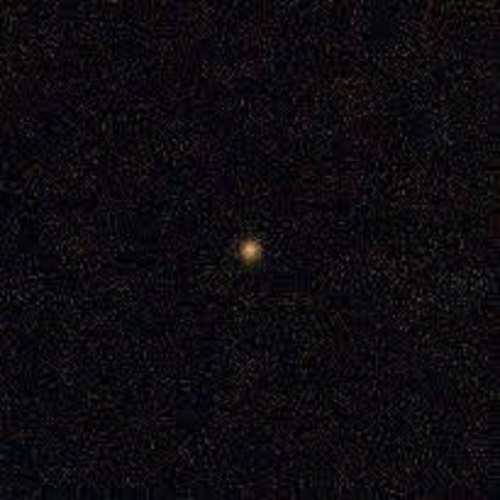
Image: This composite was produced by combining 192 images obtained through three visible and two near-infrared filters totaling 1.6 hours of integration on October 27 at the Gemini South telescope. Processing removes the background stars. The field of view represents a patch of sky 5,000 km on a side at the distance of `Oumuamua. Visible colors for the image were assigned to each filter as follows:
g (398-552 nm) = blue
r (562-692 nm) = green
i (706-850 nm) = yellow
z (830-925 nm) = orange
Y (970-1070 nm) = red
While assigning visible colors to filtered images is somewhat subjective, the resulting color of `Oumuamua in optical light is similar to the hue of some of the moons of outer planets in our Solar System, and possibly indicates a similar composition (a combination of minerals, carbon, iron, and organic compounds). Color composite produced by Travis Rector, University of Alaska Anchorage, using Gemini South GMOS data obtained and processed by Meech et. al. Credit: Gemini Observatory/AURA/NSF
Are we going to find more such visitors? Ejected comets and asteroids, forced into the deep through interactions with larger planets, may be relatively common. In fact, Robert Jedicke, who is part of the team working with Meech, estimates that a similar object, of similar size, is out there between the Earth and the Sun at any given time, up to perhaps 10 every year. If so, it will be surveys like Pan-STARRS and the future Large Synoptic Survey Telescope (LSST) that begin to compile statistics on the frequency of visitors like `Oumuamua.
`Oumuamua is now traveling at 38.3 kilometers per second relative to the Sun, about 200 million kilometers from Earth, and will pass the orbit of Jupiter in May of 2018, headed in the general direction of the constellation Pegasus. We should be able to continue to refine its trajectory as it leaves the Solar System through mid-December, when it becomes too faint to detect.
I am not saying this is going to happen, but wouldn’t it be fascinating if we learned it was headed toward another nearby star…
The paper is Meech et al., “A brief visit from a red and extremely elongated interstellar asteroid,” published online by Nature 20 November 2017 (abstract).

